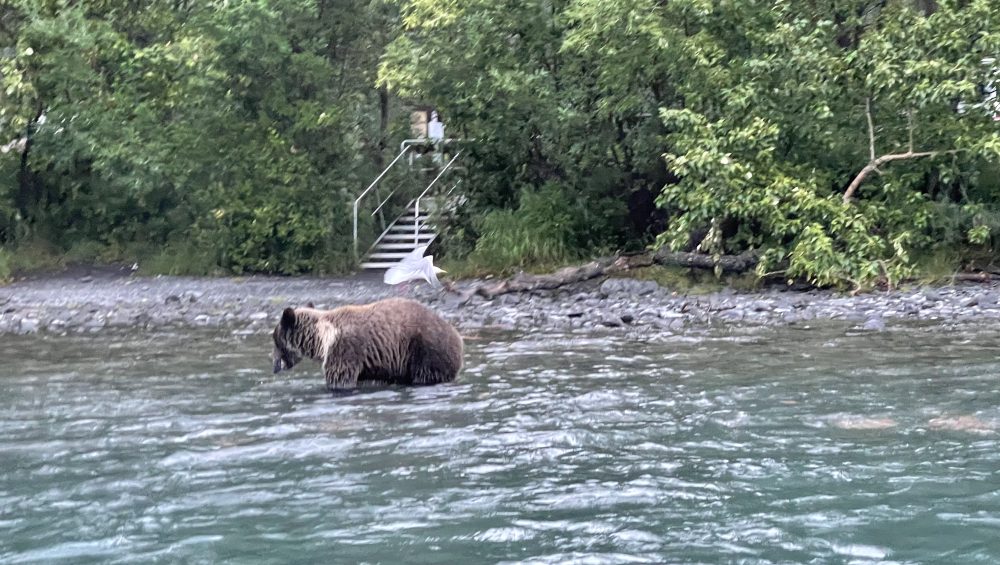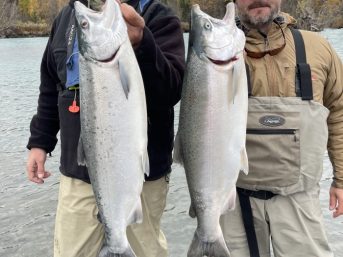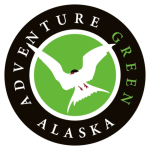The sockeyes were on the move. Limits were coming quickly and my boat was anchored on the rubble shoreline of the Kenai River and the anglers I was guiding were spread out, ankle-deep in the current, reeling them in. There was one in the party that caught a quick limit and was relaxingwith a book in the boat. I heard her exclaim, “Is that a bear over there!” I looked up and sure enough, an Alaskan brown bear was slipping into the water on the opposite shore to swim over and pay us a visit.
Everyone who comes to Alaska in the summer wants to see a bear. The Kenai River just might be the best place on Alaska’s road systems to see a brown or black bear. Alaska’s bears are everywhere from the bottom of southeast Alaska all the way to Prudoe Bay, but they aren’t always easy to find with out a big price tag because it can take a plane ride to some remote areas for the best odds of seeing one.
When we fish the Upper Kenai River after the first run of sockeye salmon show up to swim up river and spawn in the Russian River tributary, we have a great chance of seeing brown and black bears.
The bears wake up in the spring time and get real hungry real quick. There’s not a lot to forage. Just fresh grasses and shoots sprouting in the spring and tasty roots, as well as any old rotten winter kill animals and decaying salmon left over from the previous fall spawn. Bears will eat most anything they can find in the spring after their long hibernation where they lose up to – and sometime more than – 20% of their weight. When the bears pop out of their dens it takes a week or two for their metabolism to get back to 100 percent, then they need to put on the pounds to get ready for the next winter.
The Kenai River has all five pacific salmon spawning in this resource, and its many smaller tributaries make for great fishing, not only for anglers but also for the bears. The first good opportunity for the bears to get a nice easy meal is the filleted sockeye salmon carcasses that the Kenai River anglers toss back into the river after cleaning their catch. It is expected of the Kenai River and Russian River anglers to clean their fresh caught sockeye salmon on the banks of the river and throw the filleted carcasses back into the river to keep the bio mass in the water for the rainbow trout, Dolly Varden char, bald eagles, gulls, and the bears to eat. Adding to the angler’s butchered fish, the salmon that make it past the anglers and all the way to their spawning grounds perform their spawning ritual then die and there carcasses naturally stay in the river until they wash up on shore creating nutrients for all the animals in the water and forest. If anglers didn’t put the carcasses of filleted fish back in the river it would mean a lot less forage available to the wildlife.
When we stand on the banks of the Kenai River sockeye fishing, or run drifts out of our drift boats we get lots of opportunities to see both brown and black bears. The carcasses that are filleted naturally get pushed to shore and hang up on rocks and timber in the river. This creates a welcome dinner for the bears as they wander up or down the banks of the Kenai looking for the easy meal that filleted salmon provide. The best time to see the bears foraging on the banks of the Kenai is early morning. Bears are nocturnal and will be finishing up there hunt for food in the wee hours of the mornings.
If you want to see bears with out paying for an expensive scenic fly out the best bet for you is an early morning sockeye trip on the Upper Kenai River. You can hopefully get some delicious salmon for the table and see some bears all in the same day. Bears are shy and wary of people so there are no guarantees to see a bear, but your best bet at seeing a bear for an affordable price while doubling down on your money is the full day sockeye trip on the Upper Kenai River. That bear that was headed toward my drift boat from the other shore took a u-turn when we all started making noise and waving our arms. With all the carcasses drifting downstream I have little doubt the big brown bear was full and napping by noon.



